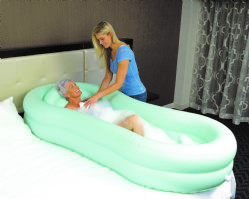Bathing is one of the most important activities of daily living, but this self-care task can be very difficult and even unsafe for people with limited mobility. One study found that up to 40% of older adults are unable to wash themselves at all due to health concerns.
It is not uncommon for older adults to receive this type of assistance from caregivers. The Centers for Disease Control and Prevention report that more than half of caregivers help older adults with tasks such as bathing. Bathing helps people maintain skin integrity and proper hygiene, but it is also viewed as a highly personal, intimate task. That being said, it’s likely that your loved one feels an intense loss of independence and dignity when they need to accept help from you in order to bathe. For these reasons and more, it’s important to approach bathing in a way that keeps your loved one safe and gets the job done effectively while remaining sensitive to their needs.
What supplies are needed for a bed bath?
It’s important to be prepared with the proper supplies before you bathe someone in bed. This will not only help the process go more smoothly, but it will prevent you from leaving your loved one unattended to retrieve certain items. It’s best to have the following materials ready before beginning your loved one’s bath:
- Deodorant or other hygiene products preferred by your loved one
- A reusable, waterproof underpad to cover the bed
- Your loved one’s choice of clean clothes
- A TV tray or tray table to hold the items
- A container or basin with clean water
- A container or basin with soapy water
- Gentle, unscented soap or cleanser
- A lightweight, full-sized blanket
- Unscented lotion
- 3-4 washcloths
- 3-4 towels
How should I prepare to give a bed bath?
- First, ensure the room is private and comfortable for your loved one. This might include closing the blinds, drawing the shades, and deploying a privacy curtain or room divider if you are in close quarters. It’s also helpful to raise the heat to a comfortable level and turn off any fans to achieve the optimal temperature.
- Fill your containers with warm water. Use your elbow to test the temperature while filling the receptacles, since the water should not exceed 115?.
- Place all other items within reach on a table.
- Carefully place the underpad (or large towels, if an underpad is not available) beneath your loved one to protect the bed. Do this by having your loved one roll on their side. Depending on their needs, they might benefit from help or supervision from a second person to do this. When they are on their side, tuck the pad underneath their thigh, then have them roll to the other side so you can repeat the same process. Once your loved one is on their back again, make adjustments to the pad as needed.
- If they need help, assist your loved one in undressing. Give them the large blanket to cover up with until their bath begins.
Keep in Mind
- Ask your loved one what else you can do to make them more comfortable. Emphasize how important bathing is, not only for their physical health and skin integrity, but also for their energy levels and sense of cleanliness.
- Do whatever you can to maintain your loved one’s dignity. Err on the side of caution in regards to their modesty: assume they will want a blanket to cover up with whenever possible and they will want some privacy to dress themselves afterwards.
- Remain tactful and positive to put their mind at ease. You can make conversation with your loved one to help them feel more relaxed. Ask them to play an active part in the bathing process, if they are able to. For example, many people will be able to use a washcloth to clean their face. If this is the case, allow them to do so. This will give them a sense of independence and restore their dignity, since this shows that you recognize their remaining abilities.
- While you are bathing your loved one, check their skin for areas that are red, swollen, dry, bumpy, tender, or warm to the touch. These skin changes could indicate the development of a pressure sore. If this occurs, be sure to notify your loved one’s doctor, since pressure sores are preventable when signs are identified early. When individuals spend a lot of time in bed, pressure sores can occur on the back of the head, shoulder blades, lower back, hips, back of the knees, ankles, and heels.
How do I give a bed bath?
- Take a wet washcloth without soap, have your loved one close their eyes, and gently wipe the washcloth across each eyelid starting at the inner corner. Take a dry washcloth and pat these areas to dab away excess water.
- Take another washcloth dipped in soapy water and wash the remaining parts of your loved one’s face, including their nose, mouth, ears, and neck. Take the same dry washcloth and absorb any excess water in these areas.
- Fold your loved one’s blanket back slightly so one side of their torso and the same leg are visible. Dip a washcloth in soapy water and wash your loved one’s shoulder, arm, and hand, one side of their torso, and their leg. Once you are done washing and drying one body part, place the blanket back over them and move to the next. When one side of the body is entirely done, wash and dry the next side following the same steps.
- Dump out the soapy water in the sink and replace it with new soapy water before you clean the genital area.
- Next, you will clean the genitals. Be thorough, as these areas can typically harbor a lot of bacteria if not cleaned properly. For women, clean from the front to the back. This technique (which is also used when wiping) will prevent the spread of bacteria from the anus to the vagina. For men, be sure to clean under and around the testicles, as this is another area that might be overlooked. In most cases, you will need to help your loved one roll to their side so you can properly clean their buttocks. For some individuals, you can access this area by placing their foot flat on the bed with their knee bent. Be sure to dry the genitals and buttocks with a separate, dry cloth after washing them.
Bed Bath Follow-up Care
- Help your loved one dress.
- Place the wet and dry towels in the laundry.
- Dump the dirty water in the sink or bathtub.
- Apply lotion to the arms, hands, legs, feet, and any other areas that are dry.
Common Issues With Bed Baths
- Caregivers can avoid getting the bed wet by placing underpads or towels under their loved one before completing the bath. They can also cut down on excess water by wringing out the washcloth before soaking it in water.
- Depending on how long the bed bath takes, it might help to change out the water periodically to ensure it doesn’t get too cold. If the water gets cold, it can make your loved one uncomfortable and they might not want to proceed. If the lightweight blanket you offer to cover your loved one up is not enough, you might want to consider offering a thicker one to keep them warm as you wash each body part individually.
- If your loved one has memory concerns or sensory issues such as vision changes, they might be resistant to bathing. Caregivers can help sidestep this by talking to their loved ones about it, making a visual schedule, or providing frequent reminders about when their next bed bath will be.
Products to Make Bed Baths Easier
Portable Shampoo Basin
A good complement to bed baths is a basin that assists with washing your loved one’s hair.
Caregivers have the option of an inflatable version or a hard plastic style. This device has a roomy basin with a thick, built-up wall to prevent spillage or splashing while caregivers wash their loved one’s hair.
Inflatable Shower Beds
Inflatable shower beds are ideal for people who require a full-body bath but cannot access a traditional bathtub or shower. This soft plastic equipment can be slid under a patient while they are lying on the bed. The shower bed can then be inflated and filled using a detachable hose. The inflatable version is most ideal for bed baths, while the bathing and shower system is more appropriate for individuals who have a much larger space to work with.
Portable Water Tank
A portable water tank can help ease the process of filling and replenishing washing basins during bed baths. There are multiple sizes to accommodate a range of needs. Some are as small as 2 gallons, which is well-suited for use with shampoo basins. Other models are larger and hold up to 10 gallons, which makes them ideal for use with full shower beds. Some also come with heating options and prevent the water from cooling during use.
Frequently Asked Questions
How often should a sedentary elderly person bathe?
In order to prevent body odor and skin breakdown, older adults should bathe once or twice per week.
How often should an elderly person wash their hair?
It is recommended that older adults wash their hair around once per week. This is best hygiene practice for most people.
Who needs a bed bath?
Bed baths are a good fit for individuals who have long-term mobility concerns that prevent them from effectively and safely entering a traditional bathtub or shower to bathe. If someone has short-term mobility problems, they might still be able to enter a traditional bath with some assistance.
Why do elderly not want to bathe?
Older adults typically experience a diminished sense of smell and vision changes that might make it hard to recognize when they are soiled. As a result, they might unintentionally neglect this self-care task. Memory loss might make it harder for older adults to get used to the idea of someone helping them bathe, which might lead to some difficult behaviors such as irritability or combativeness.
Final Thoughts
There are many ways for caregivers to make bed baths more comfortable for their loved ones. By following a set sequence and using the appropriate supplies, caregivers can improve their loved one’s hygiene, increase their well-being, and help them feel more refreshed. If caregivers are struggling with this process or their loved one is not comfortable with a bed bath, the experience can be enhanced by using equipment such as an inflatable shower bed or shampoo basin. If you have any concerns about your loved one’s skin, their ability to tolerate bed baths, or the frequency they are bathed, contact your loved one’s doctor.
>> Shop Shampoo Basins <<
Author:
Brittany Ferri, OTR/L
Brittany is an occupational therapist who has worked in a variety of rehab facilities. She has always expressed an interest in patients’ internal motivation for therapy and the use of assistive devices, which led her to pursue a PhD in Integrative Mental Health. This research-based training has also led her to develop her writing career to educate patients of all ages on how to improve their health. Brittany has published four books, written over 300 articles, and has been quoted in media outlets such as WebMD, Healthline, and NBC News.
Meet all of our experts here!
 Written by Brittany Ferri, OTR/L
Written by Brittany Ferri, OTR/L

